You have probably heard that:
- Leopard geckos are “nocturnal.”
- Leopard geckos are not demanding when it comes to lighting.
You may have even heard that because of their metabolism leos do not require any lights at all.
However, did you know that:
- To stay healthy and happy leos need a particular pattern of light and dark hours which mimic their natural habitat.
- Leos will use the lighting in their tank as an additional heat source.
Let’s shed some light on the leopard gecko’s actual lighting needs.
Do leopard geckos need light?
There is one major misconception about leopard geckos and their need for lighting – or the lack of it.
You will often hear that leopard geckos are nocturnal animals – active mostly at night. That often leads to an automatic conclusion that leos do not require any type of lighting in their tanks.
The conclusion is, unfortunately, not quite right.
First of all, there is no day without night and vice versa. Leos are aware of their surroundings even if they’re snoozing through the day. They know how to tell day from night, and they depend on it for their survival.
Secondly, leos are not nocturnal all the way – they are a crepuscular species, which means they are mostly active at dusk or at dawn. Their activity often extends into the night, true, but it is not when it begins.
Their sensitivity to the time of day means that to maintain a healthy internal clock, leopard geckos require a balanced day (light) and night (darkness) intervals.
> Read More : How to Set Up the Ideal Leopard Gecko Enclosure?
Best Leopard Gecko Lighting Setups
Here is a quick overview of a 5-element setup for any leo tank:
- Incandescent heat lamp as daylight.
- Ceramic bulb for nighttime heating, or a heating pad if your tank is too small.
- Red, blue, or black night light, which should be for a couple of hours while you want to watch your geckos (optional).
- A thermostat and a timer to optimally control your setup.
Or, you can go for a 4-element setup:
- Full spectrum UVA day light.
- Ceramic bulb for 24-hours heating (or a heat pad).
- Red, blue or black night light for a couple of hours of watching (optional).
- A thermostat and a timer to optimally control your setup.
How Much Light Do Leopard Geckos Need Per Day?
When lighting your leo tank, you will try to mimic the Middle Eastern day-night patterns. What this basically means is:
Summer: 14 hours of daytime and 10 hours of nighttime
Winter: 12 hours of daytime, and 12 hours of nighttime.
It is ideal to ensure the transition period between the seasons – gradually decrease (or increase) the intervals for 15-30 minutes per week for 4-8 weeks.
I wholeheartedly recommend you to use an automatic timer to control your lights. Unless you have rigorous personal daily routines, it is easy to forget to turn the lights on and off – and a burden to think about it all the time.
For a regular leo owner, you won’t need anything more complicated than a simple, affordable controller with no advanced options. However, due to safety, I recommend that you get the one from a reputable producer. Zoo Med’s Repti Terrarium Timer meets all those requirements.
See Zoo Med’s Timer on AmazonCan I Use Natural Window Light For My Leos?
Before even considering the possibility of using natural light in your tank, a word of caution: the greatest danger of using window light source is overheating. Unlike with bulbs, you can’t control the intensity of the sun’s rays. If the sun hits your window and the terrarium behind it directly, you may risk overheating your tank.
If the sun doesn’t hit your window directly or does so only for a short period, there should be no danger of overheating. However, I still don’t recommend this method, because it is unlikely that natural daylight cycles where you live will match those which leopard geckos are adjusted to. This is especially important if you are trying to breed leos.
Only in the case your yearly daylight patterns closely match those from leo’s natural habitat described above – then yes, leos will “use” the natural light, and their internal clock should be fine.
To find out if leopard geckos really need a UV source, please read on.
What Is The Best Type Of Light For Leopard Geckos?
When we talk about lights for leopard geckos (and other reptiles), we could divide the bulbs into four main categories:
- Daytime bulbs
- Nighttime bulbs
- Ceramic (heat) bulbs
All of these types of light have their own purpose:
- Daylight lamps simulate daylight and provide heat,
- Nighttime bulbs help you to view your pets and night and also provide heat, albeit less than the daytime heat bulbs,
- Ceramic bulbs provide heat only l(but a lot of it).
Since most lamps emit heat, when choosing the right one, you should also consider the way a particular bulb will affect the temperature in your tank. Lights can be used as a primary or an additional heat source, and/or can help you to create a temperature gradient within the tank. However, be mindful that different types of bulbs produce different amounts of heat. For example, mercury-vapor bulbs can get too hot for small tanks typically used for leopard geckos.
The Right Daytime Lighting For Leopard Geckos
As crepuscular/nocturnal lizard that rarely basks under the light source, the leopard gecko is not overly sensitive to the properties of artificial light in the tank. In the earlier days, the standard opinion was that since leopard geckos are “nocturnal,” they do not need any amount of UV light. The tank light was primarily considered a leopard gecko heat lamp, so merely providing them with a daytime heat lamp for the right amount of hours per day was considered to be enough.
However, in recent years, this practice has been up for debate.
Do Leopard Geckos Need UVB?
The relationship between UVB, Vitamin D3 and the activity patterns of various reptile species is a complex subject, which scientists don’t fully understand.
Generally speaking, most experienced keepers have maintained diurnal species — who presumably require UVB radiation to produce sufficient Vitamin D3 — by providing them with UVB lights. Conversely, nocturnal species, who do not enjoy much exposure to UVB rays, are rarely provided with true full-spectrum lighting, as they’re thought to be able to obtain all of their Vitamin D3 through dietary means.
This means that — historically — leopard gecko keepers and breeders have satisfied their lizards’ D3 needs via a well-rounded diet and supplements.
However, it is important to note a few things:
- There are exceptions and outliers to the assumption that diurnal reptiles require UVB light. For example, very few (if any) snakes are thought to require UVB lighting, including strictly diurnal species.
- A very small number of leopard geckos display symptoms of metabolic bone disease. In some cases, this appears to have occurred even when the lizards were given supplements. However, because these reports are anecdotal, the specifics of these situations are not well documented, which leaves more questions than answers.
- Leopard geckos are probably better described as crepuscular — active at dawn and dusk — rather than nocturnal. So, they likely receive some UVB exposure in the wild.
Given these factors, some keepers have decided to start experimentally providing UVB lights for their leos.
Only time will tell if this approach is safe and beneficial. We don’t even know if leopard geckos can perceive UVB rays like some other reptiles can, nor do we know yet whether or not these lights are harmful to them.
Additionally, it is important to remember that tens of thousands (and potentially hundreds of thousands) of leopard geckos have lived long, healthy lives without UVB lights. Indeed, few large-scale leopard gecko breeders (if any) employ UVB lights with their lizards.
Accordingly, hobbyists are encouraged to approach the UVB issue carefully. It seems highly unlikely that they require UVB lighting, and we know that the vast majority of leopard geckos will remain healthy if provided with a proper diet and supplementation schedule. Just be sure to discuss the issue with your veterinarian if you’re inclined to experiment with UVB lights.
Incandescent Daylight Bulbs for Leopard Geckos
The standard incandescent – tungsten or halogen – bulbs and lamps will do just fine as a primary light and heat source. They emit mostly yellows and reds with no blue part of the spectrum.
The regular home incandescents of proper wattage will do just fine. However, there are also specialized incandescent bulbs for reptiles which are a bit more refined. For example, this Zilla Reptile Day White Terrarium Incandescent Heat Lamp simulates natural daylight by using neodymium glass, which produces brighter, whiter light. It emits light at wavelengths from 400nm to 700nm for visual (visible) light and UVA rays from 315nm to 400nm.
See Zilla Heat Lamp on AmazonFull Spectrum Daylight Bulbs for Leopard Geckos
The term “full spectrum” is used in many ways by reptile keepers, but it usually refers to lights that produce UVA and UVB wavelengths.
As mentioned before, it isn’t clear whether or not UVB-producing bulbs are safe or helpful for leopard geckos. So, it is probably wise to avoid using these types of UVB-producing bulbs unless you are working in conjunction with your veterinarian and using them carefully.
However, if by “full spectrum” lights, you simply mean lights with a well-balanced color spectrum, which will help your leopard gecko and his habitat look their best, there is no reason you can’t do so.
If you want to use a bulb that produces no UVB, just go with something simple, like these Daylight Fluorescent Bulbs. On the other hand, if you do want to try UVB lights with your pet, be sure to stick to ones that produce relatively little UVB, such as these Zoo Med Compact Fluorescent Bulbs.
Leopard Gecko Lighting At Night
Unlike the daytime bulbs, night lighting for leopard geckos isn’t there to simulate daylight – but to enable you to watch your geckos in the evening or at night, when they are the most active. It is like fake moonlight, but with another additional feature. Unlike the moonlight, night lights will also provide some heat.
You’ll be able to find three main types of night lights on the market:
- Red lights
- Blue lights
- “Black” lights
All of the types do pretty much the same thing – heat the terrarium while adding some discrete light in the part of the spectrum that reptiles are thought not to see.
However, this is another topic of hot debate.
An ideal night light will give off just enough light for you to watch your geckos but will be low enough not to disturb your sleep or pet’s activities. Still, it turned out that the assumption that nocturnal reptiles can’t see the red lights is not entirely accurate. Even if they can’t see red, they can still see the light itself – like colorblind people.
I had used a red light in my tank for a few years. In all that time, I had never noticed that my leos were disturbed by the red bulb. Their pupils were dilated as if it was dark, and they would go about their business normally. While I haven’t experimentally compared the activity level with and without the light, I don’t use any type of night light anymore out of precaution nevertheless.
This doesn’t mean you shouldn’t use these bulbs at all, although they are absolutely not necessary. I would advise that you keep them on just as long as you want to watch your leos, and not the entire (night)time.
Leopard Gecko Red Nighttime Bulbs
Red bulbs are commonly used as night lights + heaters in tanks, many of them running for 24 hours each day. They are almost always marketed as “infrared,” though this is not entirely true – the heat that the bulbs emit does belong to the infrared part of the spectrum. However, the visible red light is just that – part of the visible light spectrum.
A quality bulb, like the Zoo Med Nocturnal Infrared Incandescent Heat Lamp (75 Watts) is not merely coated with red paint, but it is made out of genuine red glass. Zoo Med also claims that this bulb emits only a small part of visible light and that it will not interfere with your pet’s day-night cycle.
Leopard Gecko Blue Night Lights
Blue night lights, like this Exo Terra 100 Watt Night Heat Lamp, simulate moonlight by giving off a bluish glow. This will give your tank a more natural look, though some people still prefer the warm glow of infrared lights. When it comes to how potentially disruptive they are, there is no known difference between blue and red lights.
Also, the blue lamps don’t emit a lot of heat and won’t interfere with maintaining the natural nocturnal temperature drop.
Leopard Gecko “Black” Night Lights
Due to concerns about disturbing nocturnal pets, some producers have developed the so-called “black lamps,” such as this Zilla Night Black Heat.
See Zilla Night Back Heat on AmazonThe black light bulbs are claimed to emit very little visual light, giving off only a discrete purplish glow while providing heat. However, their exact effect on leopard gecko’s vision and still unknown, and it is unclear if they are really superior to its black and red counterparts. Black lights are used in the same manner as red and blue lights.
Day/Night Light Combos
Some manufacturers offer combos of day and night bulbs at affordable prices, as well as the fixtures to house them in.
See Zoo Med Light Combo on AmazonIt the case you find quality goods, this can be practical both in the sense of purchase, and the time and space required to install the fixture.
Durability of Light Bulbs
The reviews on the durability of various incandescent bulbs vary greatly. While most manufacturers guarantee a particular lifetime, customers often report that even bulbs from reputable brands burn out much quicker than that. Others, however, report no issues of such kind.
That can be at least partially explained by the fact that the light bulbs are sensitive objects which can be damaged by bad handling. Mishaps can happen both with pet stores and online ordering. So besides informed decision, buying a long-lasting bulb is also a matter of luck.
Always follow the manufacturer’s instructions on how to properly use and house the bulbs. Some are sensitive to overheating, which can happen if they are closed in domes.
Ceramic Heat Bulbs For Leopard Geckos
Despite the marketing, red and blue lights will inevitably emit some percentage of light that is visible to your pet reptile. If you notice a change in behavioral patterns in your leos after adding the nocturnal light, or if you are just cautious like me, then a ceramic bulb – also called a ceramic heat emitter (CHE) – could be a good solution.
Ceramic bulbs are not true light bulbs – because they emit no light, but only heat. However, “heat” actually belongs to the infrared part of the spectrum, making ceramic heat bulbs the real infrared bulbs. And, they provide natural heat, because it comes from above, like the heat of the sun, or the hot rocks above leo burrows. Another upside of CHEs is that they last much longer than any light bulb.
It is better to use CHEs with porcelain sockets, because the plastic ones may melt due to high heat. Also, never touch the heated bulb!
Be careful if you have a small tank – most CHEs emit too much heat for tanks of 20 gallons and under. You should definitely have a thermostat, but you can additionally control the heat output by getting a dimmer switch, or by raising the bulb well above the tank.
ZooMed’s ReptiCare Infrared Ceramic Heat Emitter uses a standard (ceramic) incandescent socket and promises a long lifetime – as long as 5 years.
See Zoo Med Heat Emitter on AmazonSince CHEs are powerful, you will want them to be thermostatically controlled (and I recommend the same for all other heat sources). ReptiTemp RT 600 Digital Thermostat Controller lets you control up to 600 watts of heating devices, and controls temperatures in the range from 50 degrees F to 122 degrees F (10-50 degrees C). Also, it has a built-in alarm which will warn you of extreme temperatures.
See ReptiTemp Thermostat Controller on AmazonLeopard Gecko Lighting Tips
Here are a few general rules you should know when setting up a light in a leopard gecko tank, which can also be applied to all other lizards.
- The light should always be placed directly above your tank, and not come from the sides. See those ridges above your leo’s eyes, the “eyebrows”? They exist to shade their sensitive surface of the eye, but obviously, don’t work if you put the light on the side of the tank.
- Ideally, the light should be placed above and not inside the tank. Lamps that rest on the mesh lid are also fine.
- Do not get the bulb that is too powerful for the size of your tank.
- Set the lights at a proper distance. No light should be closer than six inches from your pet. This gets more complicated in the case your leo can climb all the way to the lid (e.g., stone or 3D background); in that case, the lamp should definitely be hanging over the tank.
- Always check the temperature below the heat lamp.
- Always use guards if your gecko can get near the heat bulb.
- Always follow the manufacturer’s instructions on how to use that bulb.
- Provide hides and caves both on the light side and the darker side of your tank.
It’s Your Turn
I hope I have managed to light up this often neglected, but an important leopard gecko housing topic. Although leos are not as sensitive to the quality of light as some diurnal lizard, the presence and type of lighting has the power to enhance your leo’s life substantially. That is why the right lamps, bulbs, and fixtures are worth the time and the money you will invest in them.

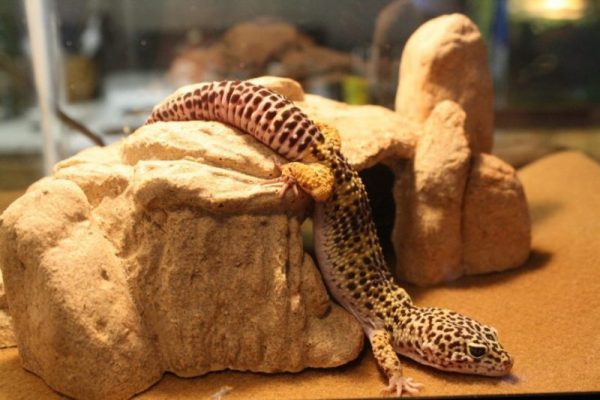
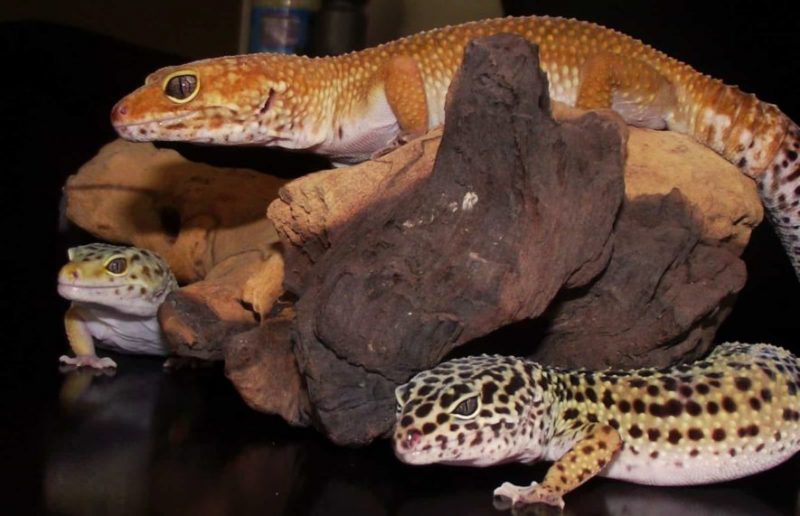
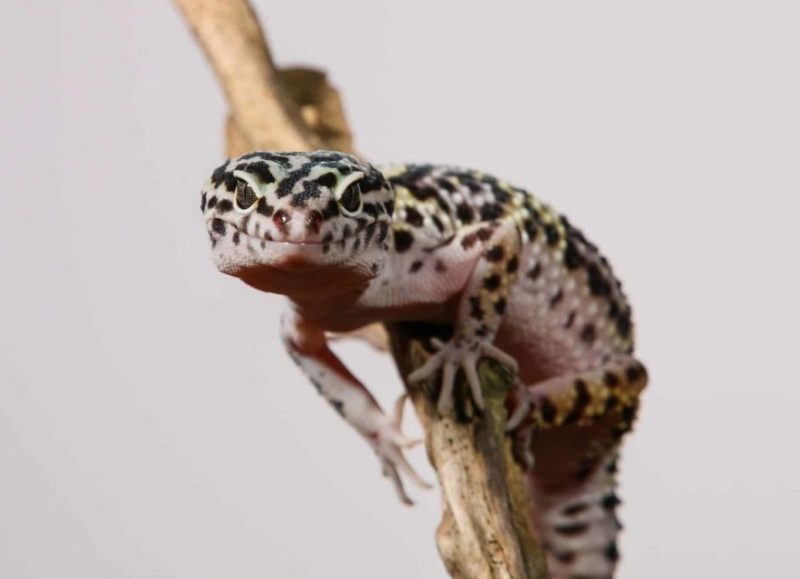
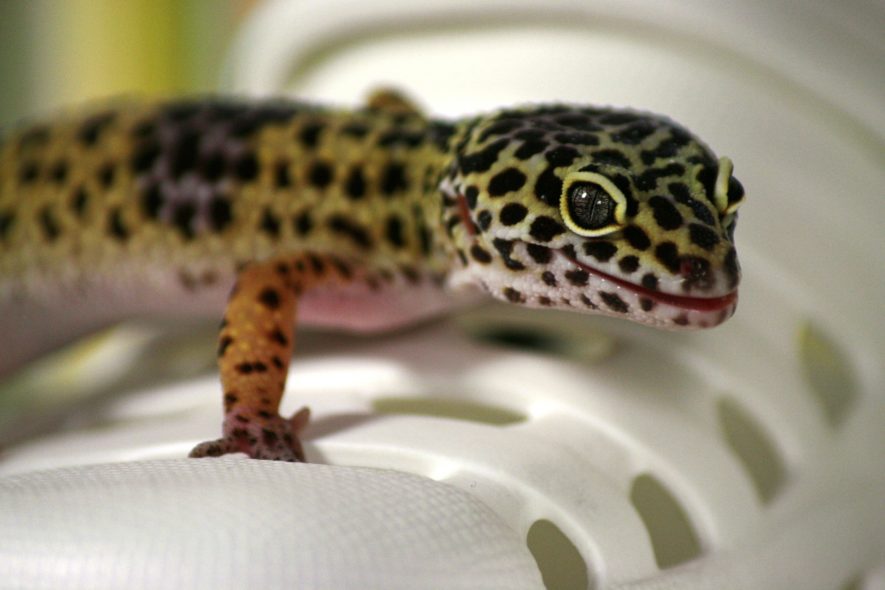
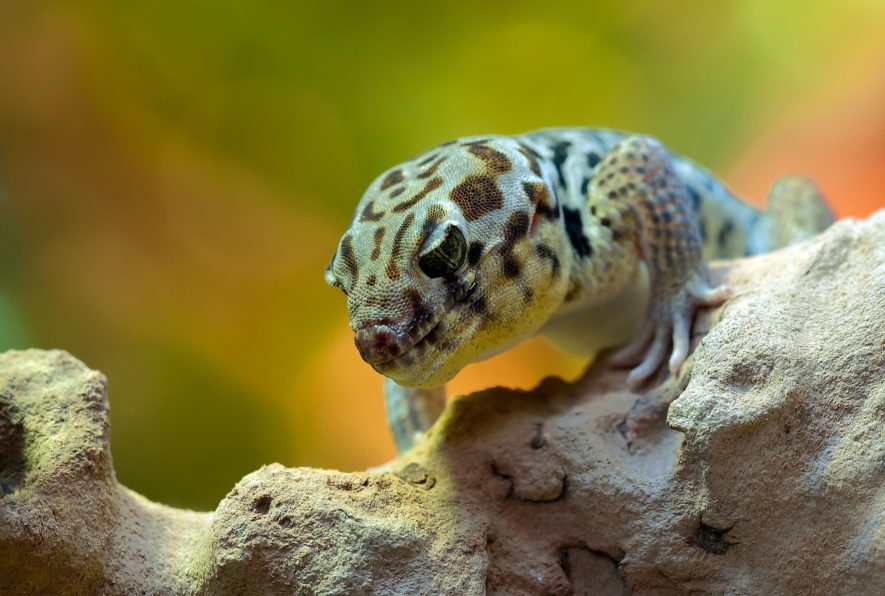
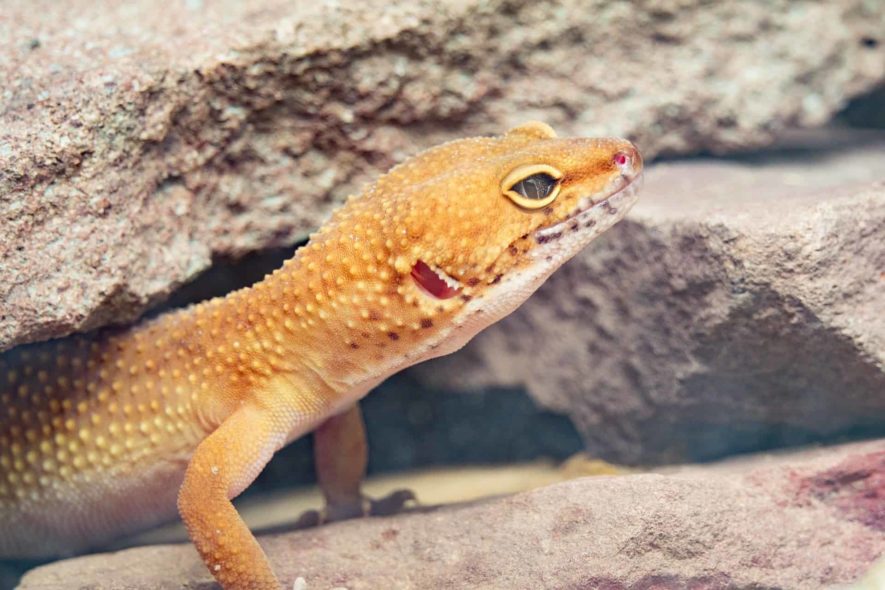
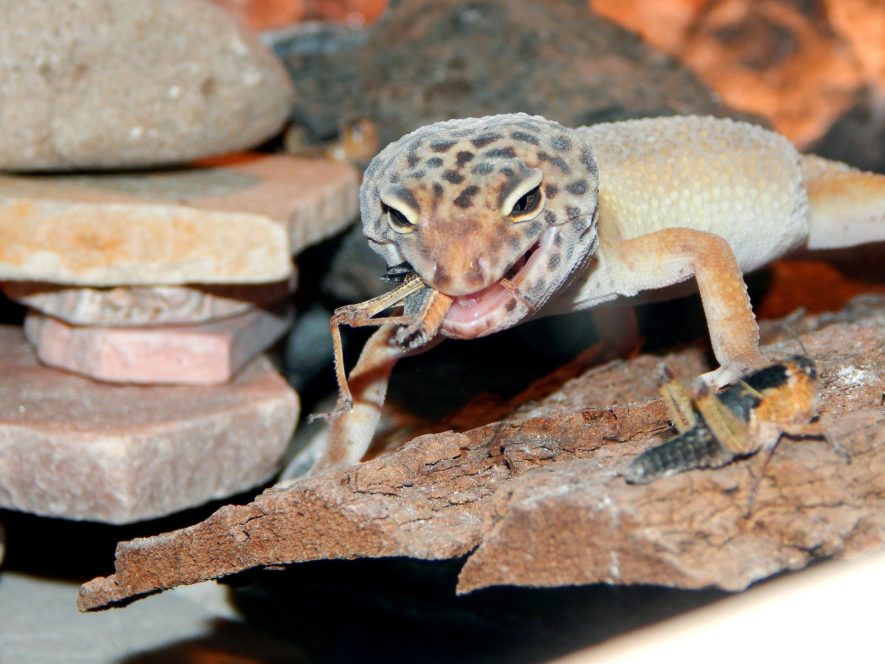
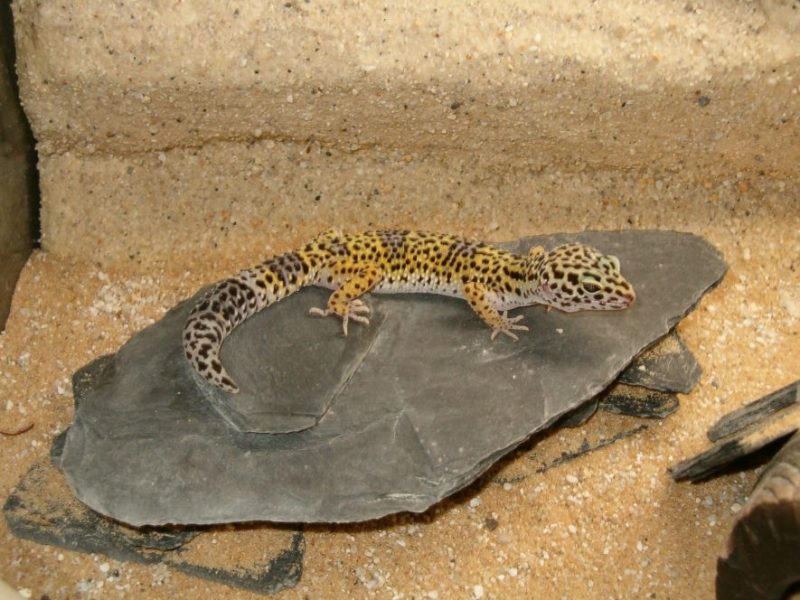
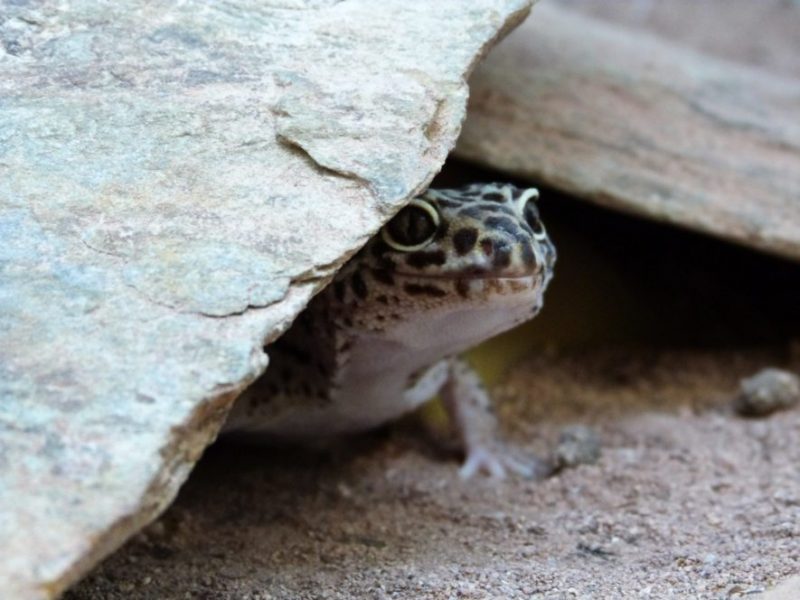

55 Comments
Thanks for sharing the informative article.